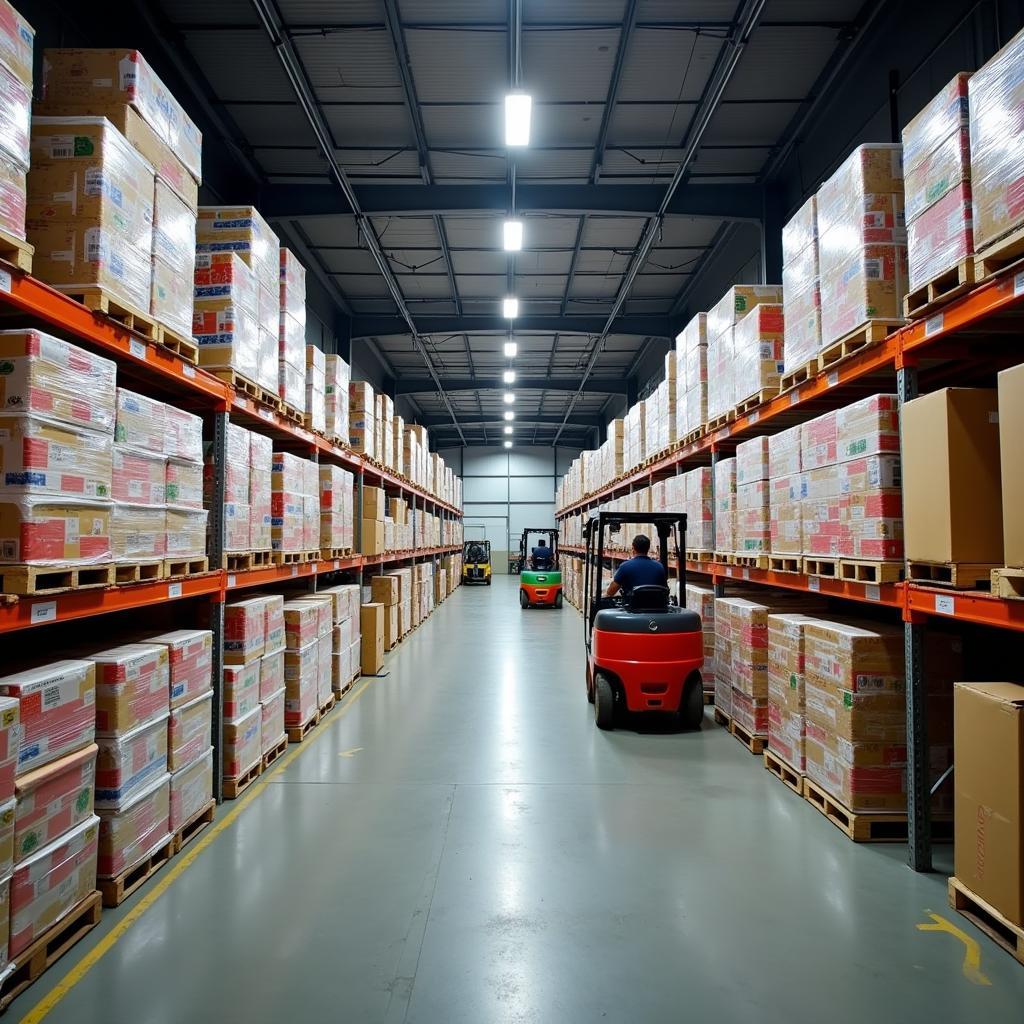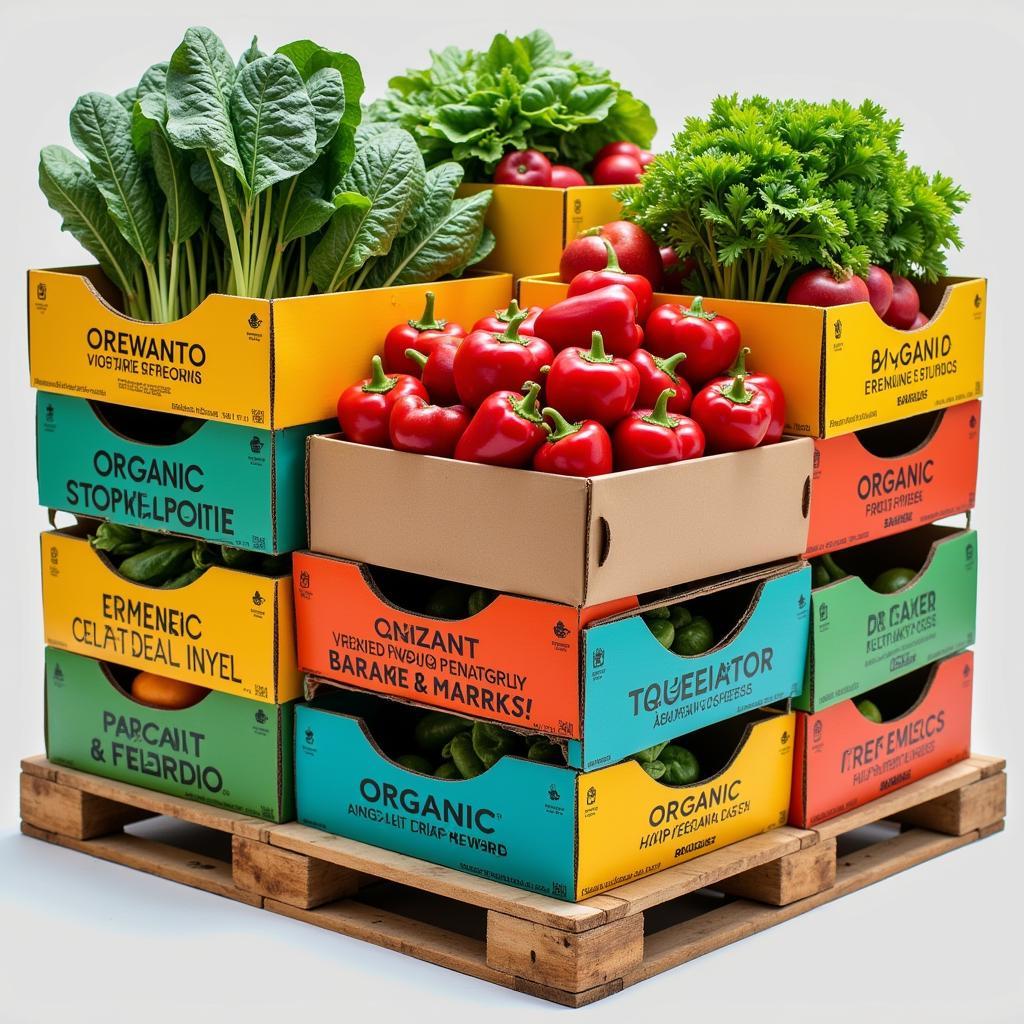Pallets Of Food offer a fascinating glimpse into the world of wholesale, retail, and even disaster relief. From bulk purchases for restaurants to discounted goods for savvy shoppers, the world of pallets of food is vast and varied. Let’s dive into what exactly a pallet of food entails, the advantages and disadvantages, and how to navigate this unique marketplace.
What are Pallets of Food?
Pallets of food are simply large quantities of food products, typically packaged and stacked on a wooden pallet for easy transport and storage. These pallets can contain anything from canned goods and dry ingredients to frozen meals and fresh produce. They’re commonly used in the wholesale food industry, allowing businesses to buy in bulk.  Pallets of food stacked high in a large warehouse, ready for distribution.
Pallets of food stacked high in a large warehouse, ready for distribution.
Why Buy Pallets of Food?
For businesses, purchasing pallets of food wholesale offers significant cost savings, especially for high-volume establishments like restaurants, cafeterias, and catering companies. But it’s not just businesses that benefit. Individual consumers can also find incredible deals on food liquidation pallets, often at deeply discounted prices.
The Advantages of Buying in Bulk
- Cost Savings: Buying in bulk often translates to lower per-unit costs.
- Convenience: Having a large supply on hand reduces the frequency of shopping trips.
- Reduced Waste: While it may seem counterintuitive, buying in bulk can actually reduce food waste if managed properly.
Navigating the Challenges
- Storage Space: Pallets of food require significant storage space, which can be a challenge for individuals or small businesses.
- Expiration Dates: Careful attention must be paid to expiration dates, especially for perishable items.
- Quality Control: While most pallet sellers maintain high standards, it’s essential to inspect the goods upon arrival to ensure quality.
Where to Find Pallets of Food
Several online marketplaces and liquidation companies specialize in selling pallets of food. You can also find deals through local wholesalers and even some retail stores. Be sure to do your research and choose a reputable seller. Don’t forget to check for pallets of dog food for sale too if you have furry friends!
What to Expect When Your Pallet Arrives
Your pallet will likely arrive via freight shipping. It’s important to be prepared to receive and unload the pallet, which may require a forklift or pallet jack. Inspect the goods immediately and contact the seller if there are any issues.
How Can a Food Wrap Machine Help?
Investing in a food wrap machine can be a game-changer for preserving and storing large quantities of food, especially if you regularly purchase pallets of food. It allows you to repackage bulk items into smaller, more manageable portions, helping to extend their shelf life and reduce waste.
“Proper storage is key to maximizing the value of your pallet purchase,” says renowned food preservation expert, Amelia Garcia. “A good quality wrap machine allows you to portion and preserve your food efficiently, minimizing spoilage and saving you money in the long run.”
Are There Pallets of Specialty Foods?
Absolutely! You can often find pallets of organic foods, gluten-free products, and even specialty items like gourmet cheeses or imported delicacies.  A vibrant pallet of fresh, organic produce, including various fruits and vegetables. For those seeking high-quality pet food, consider looking into raw dog food suppliers who might offer pallet options.
A vibrant pallet of fresh, organic produce, including various fruits and vegetables. For those seeking high-quality pet food, consider looking into raw dog food suppliers who might offer pallet options.
“Sourcing high-quality ingredients in bulk is essential for any successful food business,” adds culinary consultant, Julian Dubois. “Pallets of specialty foods open up a world of possibilities for chefs and food entrepreneurs seeking unique and premium ingredients.”
Conclusion
Navigating the world of pallets of food can be a rewarding experience, offering both significant cost savings and access to a wide variety of products. With careful planning and a little research, you can unlock the potential of pallets of food and enjoy the benefits of buying in bulk. Remember, finding pallets of food isn’t just about saving money; it’s also about accessing a wider range of products, reducing waste, and potentially supporting businesses that offer unique or specialized food items.
FAQ
- What is the average weight of a pallet of food? The weight varies greatly depending on the contents, but typically ranges from 1,000 to 2,000 pounds.
- How are pallets of food shipped? They are typically shipped via freight.
- Can I buy a partial pallet? Some sellers offer partial pallets, but it’s less common.
- What happens if my pallet arrives damaged? Contact the seller immediately to resolve the issue.
- How can I find reputable pallet sellers? Research online and check reviews before making a purchase.
- Are pallets of food always discounted? While often discounted, pricing varies depending on the contents and seller.
- What are the best storage practices for pallets of food? Store food in a cool, dry, and well-ventilated area.
For support, contact us 24/7: Phone: 02437655121, Email: [email protected], Address: 3PGH+8R9, ĐT70A, thôn Trung, Bắc Từ Liêm, Hà Nội, Việt Nam.